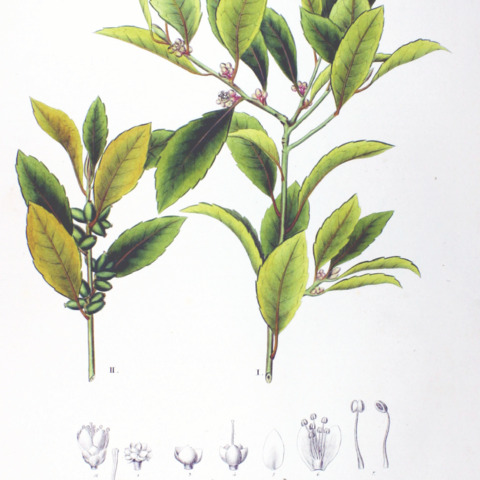Shrubs or trees, deciduous [evergreen], often accumulating aluminum, tanniferous. Leaves alternate, spirally [distichously] arranged, simple; stipules absent; petiole present; blade margins serrate, serrulate, dentate, or crenulate-serrulate, sometimes nearly entire. Inflorescences usually axillary, rarely internodal, panicles or fascicles [racemes, spikes, or solitary flowers]. Flowers bisexual [unisexual]; perianth and androecium epigynous; hypanthium adnate to ovary wall; sepals [3-]5, connate proximally; petals [3-]5[-11], connate proximally [to middle]; nectary disc present; stamens ca. 40-100 [rarely ca. 5-15 in dioecious species], adnate to corolla at base [to middle], 1-4-seriate, in antisepalous fascicles [± evenly distributed]; anthers dehiscent by longitudinal slits; pistils 1, 2-3-carpellate; ovary inferior [subinferior], incompletely 2-or 3[-5]-locular; placentation mostly axile (intruded); ovules anatropous, unitegmic, tenuinucellate; styles 1, hollow, filiform [subulate]; stigmas 1, 2-5-lobed [capitate]. Fruits drupaceous. Seeds 1[-5], brown, ovoid or reniform, [ellipsoid, ampulliform, U-shaped, or S-shaped]; embryo straight [curved]; endosperm copious, oily.
Shrubs or trees; indumentum, where present, of simple hairs. Leaves alternate or spirally arranged, usually evergreen, often drying yellow, simple, petiolate, entire or toothed, venation pinnate; stipules absent. Inflorescence axillary or terminal, racemose or spicate, or flowers solitary. Flowers bisexual, sometimes unisexual, actinomorphic, fragrant, usually subtended by a bract and 2 bracteoles; hypanthium present. Sepals 3–5, fused basally. Petals 3–11 (–15), free almost to base or fused to middle. Stamens (4–) many, in 1–4 rows, epipetalous, often in 5 bundles, filaments free or fused basally; anthers bilocular, opening longitudinally. Gynoecium of 2–5 fused carpels. Ovary inferior, sometimes semi-inferior, 2–5 locular; ovules 2–4 per locule; style simple, slender. Fruit a berry or drupe, crowned by persistent calyx, 1–5-locular, 1 seed per locule. Seed with curved or straight embryo.

